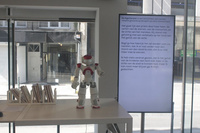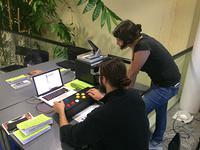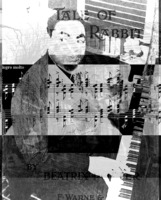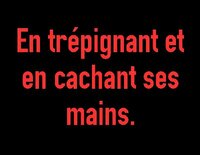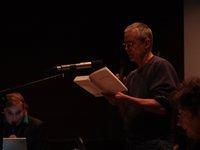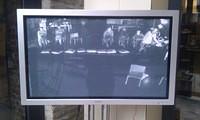Algorithms and Text
What does it mean to work with text in a digital infrastructure? As an artist, writer, storyteller? Over the years, various research questions around this theme have crisscrossed the workings of Constant. How can a machine read a poem in an authentic way? What does collaborative authorship mean? How do you make non-linear narratives? How can you use programming language to generate stories? Which stories do complex computer models tell if you let them talk without an interface? This weft tries to give an overview of works and activities that touched upon different aspects.
Experiments with databases
DiVersions
Oct 2019, June 2020
DiVersions experiments with online collections of cultural institutions as sites for decolonial and intersectional practice. Inspired by the way versioning functions in networked software tools, seven media installations and this publication explore how online collections can accommodate radically different, and sometimes opposing perspectives.
https://diversions.constantvzw.org
The collection of uncertainties
The Collection of uncertainties finds its sources in public, digitized heritage collections, and consists in the entire set of “artefacts” marked by the presence of lexical fields pertaining to the notion of “uncertainty” in their archival records. The collection is in perpetual evolution, and evolves along the uncertain knowledge and recognitions of the scientific world.
The project is led by Marie Lécrivain and Colm O’Neill and was supported by Fédération Wallonie-Bruxelles, La Houle and Constant vzw.
https://di.versions.space/collection-of-uncertainties
When organic trees meet the data tree
Wikipedia and Wikidata are used worldwide to train language software, such as translation apps and autocomplete functions in search engines. Wikipedia and Wikidata data is accessible and free of charge, the information is up-to-date and exists in many different languages. When organic trees look for how they are represented in these databases, cultural and power structures become visible. This work makes it clear, for example, that not all languages are present in the same way. Moreover, the search term tree leads to individual trees, such as the chestnut tree that grew next to Anne Frank’s house. Whereas even a child can easily point to a tree in physical life, the concept of a tree is a challenge for programmers in the digital world. ‘When organic trees meet the data tree’ gives a voice to trees, algorithms and people. Their visual stories give a critical view on the creation process of apps and other software we use on a daily basis.
https://di.versions.space/when-organic-trees-meet-the-data-tree/index.html
Post-digital Archive Experience
In 2017 Peter Westenberg and An Mertens were invited to Aalborg University, to give a workshop and a masterclass for a group of students of the Erasmus JMD program in Media Arts Cultures. They invited the students to create a database from the objects in their backpack. As a result wonderful stories and discussions emerged.
http://constantvzw.org/site/Post-digital-Archive-Experience.html
Machine Learning experiments
Data Workers
March 2019, Mundaneum, Mons[nl] [fr]
Data Workers was an exhibition of algoliterary works, of stories told from an ‘algorithmic storyteller point of view’. The exhibition was created by members of Algolit. Some works were by students of Arts² and external participants to the workshop on machine learning and text organized by Algolit in October 2018 at the Mundaneum.
The exhibition foregrounded data workers who impact our daily lives, but are either hard to grasp and imagine or removed from the imagination altogether. It connected stories about algorithms in mainstream media to the storytelling that is found in technical manuals and academic papers. Robots were invited to engage in dialogue with human visitors and vice versa.
https://algolit.net/index.php/Data_Workers
The Algoliterator
May 2018, Public Domain Day, Muntpunt, Brussels
The Algoliterator was trained using a neural network and the full works of Belgian author Felix Timmermans, who entered the public domain in 2018. The Algoliterator helped you to write a text in the style of Timmermans. You could choose a start sentence from his oeuvre, you could also choose whether you wanted the Algoliterator to produce the following sentences based on primitive training, intermediate training or final training. The machine proposed a paragraph that you can edit. If you were happy with the result, you could send it to Zora, the house robot of Muntpunt. She would read out the text for you.
https://algolit.net/index.php/Algoliterator
Algoliterary Encounters
November 2017, La Maison du Livre, Brussels
Algolit explored the narrative perspective of machine learning algorithms as playful and legible stories. Taking implemented models as a starting point, they tried to get a grip on some of the materials that are used in applications around the web. During the Algolitery Encounters, the members of Algolit shared a part of this research. They presented lectures, workshops and a small exhibition.
https://algolit.net/index.php/Algoliterary_Encounters
Machine Research
Cqrrelations
January 2015, deBuren, Brussels
Cqrrelations was a work session inviting data travellers, writers, numbergeeks, programmers, artists, mathematicians, storytellers, and other tech creative souls to explore the world of digital non-relations, desnalysis, blurry categorisations and crummylations in the Big Data that shapes our daily reality and language.
https://cqrrelations.constantvzw.org
Playing with literature
Constant_V: On Journey with Hovelbot
Oct 2016, Constant, Brussels
New landscapes are in the making by how we interact with our telephones and computers. Two hundred years after Mary Shelley wrote her novel Frankenstein, Hovelbot is a computer program that, just like Frankenstein’s monster, quietly observes how humans live, in order to learn and be able to share its stories with them. The visitor is asked to connect her phone to a local network. By doing so, the visitor can observe how the hidden activity happening on her device is giving form to Hovelbot.
In return Hovelbot takes its unintentional “teachers” on a narrative journey that, even though it might remind us of the 19th century romantic pursues, will rather be a confrontation between our networked self and the artificial beings that make this network.
http://constantvzw.org/site/On-Journey-with-Hovelbot,2661.html
Frankenstein revisited
Oct 2016, Mad Scientist Festival, Museum for Art & History, Bern, CH
All information, publication and code: http://www.algolit.net/frankenstein/
With: Piero Bisello (art historian & writer), Sarah Garcin (graphic designer and programmer), James Bryan Graves (computer scientist), Anne Laforet (artist & critic), Catherine Lenoble (writer) and An Mertens (artist & writer). [nl] [fr]
Algolit
In 2012 An Mertens and Catherine Lenoble initiated Algolit, together with Nicolas Malevé and Olivier Heinry. Algolit is a workgroup around i-literature, free code and texts. In January 2019 the group became independent. The members meet regularly following the principles of the Oulipo-meetings: they share work and thoughts and create together, with or without the company of an invitee. Algolit is open to anyone interested in exchanging practises around digital ways of reading and writing.
http://constantvzw.org/site/-Algolit,184-.html
https://algolit.net
A hybrid novel: CIAO/Tot Later 1.0[nl]Een hybride roman: CIAO/Tot Later 1.0 [fr]Un roman hybride: CIAO/Tot Later 1.0
Constant published the hybrid novel CIAO/Tot Later - the author’s cut, by An Mertens, an object that is a beautiful book typeset by OSP accompanied by a digital story narrated through webpages.
Online story:https://www.adashboard.org/ciaocu/
Physical book:https://www.books.constantvzw.org/home/ciao
http://constantvzw.org/site/CIAO-Tot-Later.html
VJ9: The language of sharing
In 2005 Constant invited Jacques Jouet, member of Oulipo, to read his poetry during the 9th edition of Verbindingen/Jonctions. Oulipo stands for ‘Ouvroir de Littérature Potentielle’, they generate their ‘potential’ literary creations using scores that could be translated to lines of code. The ‘Metro Poem’ for example, is written while taking the metro. The verses need to be written during the trajectories between the different stops of the metro.
Image as text
Erkki Kurenniemi (In 2048), Imagine a picture
For Documenta 13 Nicolas Malevé and Michael Murtaugh developed a series of experiments in connection with the archive of Erkki Kurenniemi, the Finnish artist and technology pioneer of the 1960s. Over the years, Kurenniemi obsessively documented his everyday activities, collecting vast amounts of audio-visual-textual material to make a digital ’back-up’ of his life as a template for all human life. As part of the research Nicolas wrote the poetic text ‘Imagine a picture’.
The project was commissioned by KURATOR and dOCUMENTA (13) in partnership with Central Art Archive of the Finnish National Gallery (Perttu Rastas), and Contemporary Art Museum KIASMA, Helsinki. Supported by Arts Council England.
Read the text:http://kurenniemi.activearchives.org/logbook/?page_id=521
Tagging Matters
In 2011 Tagging Matters explored the writerly work of tagging in relation to ideas behind the Semantic Web. Active Archives started on the principle of “we are no islands”, looking for ways of linking on-line resources with respect for specific data practices. Open Data, Linked Data and Resource Description Frameworks (RDF) promise the linkage of dispersed data without the need for centralization. Yet popular Semantic Web projects such as Freebase and DBpedia suggest a need for centralized linked data repositories. This workshop looks for a means of protecting “private” writing spaces that allow locality and difference to be preserved while still providing a means of making connections between institutions and individuals.
The worksession was a mix of collaborative exercises, informal presentations and prototyping sessions.
http://constantvzw.org/site/Tagging-Matters-Kitchentable.html
Timed Text
A four-day worksession in 2010 aimed to further develop the Active Archive Video Wiki, a tool designed to break open the “black box” of online video. Users were encouraged to write with subtitles and video, creating new compositions made from disparate (online) elements. The AA Video Wiki allows resources to remain “active”, in-place and online.
http://constantvzw.org/site/Active-Archives-kitchentable.html
In situ stories
Stitching Stories
In December 2010 Ping, the association for multimedia ressources and innovative projects in Nantes, invited Constant to host the creation workshop with elderly people in the framework of ’Rejoignez-nous - soyes branché-e-s’. Nicolas Malevé, Wendy Van Wynsberghe, Peter Westenberg and An Mertens invited the participants to reflect upon their relation to the places where they worked (in the large sense of the word: not only the factories and offices but also the places where they executed household works). The stories based on interviews, were implemented on two sound cartographies, a physical one - on textile - and a virtual one - on line.
http://constantvzw.org/site/Stitching-Stories.html
https://www.amotscousus.constantvzw.org/
https://www.renum.net/leblog/?p=743
Public Writer
In February 2010, Public Writer was a writers’ cabinet in the Sans Souci Library, where you could order a letter, story or poem - analogue or digital - for your beloved person (partner, child, family member, friend). Visitors could choose their gift layout styles from a catalog. The catalog was the result of an experiment with Open Office, an everyday digital writing tool. Using a series of computer scripts, the graphic designers of the collective Open Source Publishing (OSP) produced 126 different style combinations to choose from.
http://osp.kitchen/work/openbaar-schrijver/
La Langue Schaerbeekoise/De Schaarbeekse Taal
Michael Murtaugh (software) and Peter Westenberg (bricolage) created a mobile recording device that is very popular with children ! With one push on the button of the joystick you record, while with another button you can immediately play the sound. You can also record new sound while playing back existing words. Or you can use the buttons to mix live with the words from the dictionary.
http://www.lalangueschaerbeekoise.be/p/rugzak.html
Transcommunautaire Karaoke Transcommunautaire
In 2007 Constant created an installation at Passaporta during BRXLBRAVO with texts of Paul Van Ostaijen and Suzanne Lilar. All visitors lent their voice to the computer. They recorded words of the texts in French and Dutch. One could thehear how the machine presented the two texts using hundreds of different voices of the Brussels visitors.
http://constantvzw.org/site/Transcommunautaire-Karaoke,415.html


